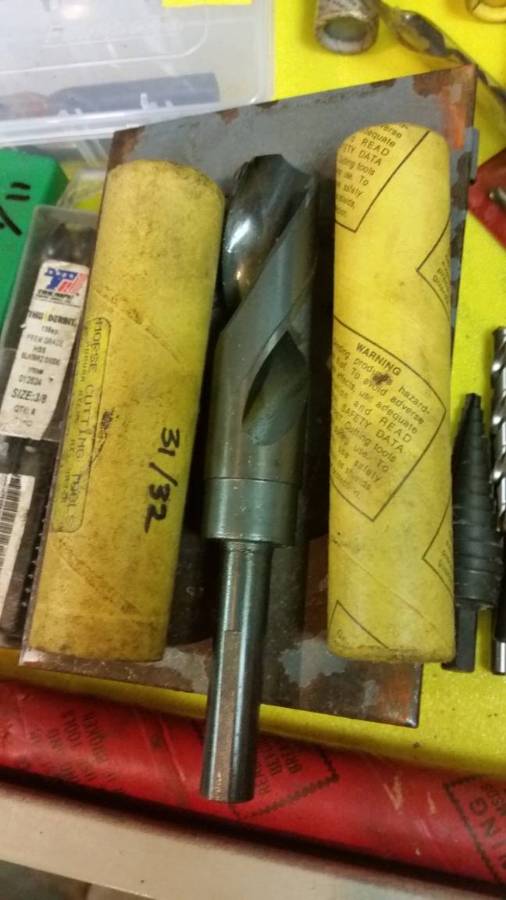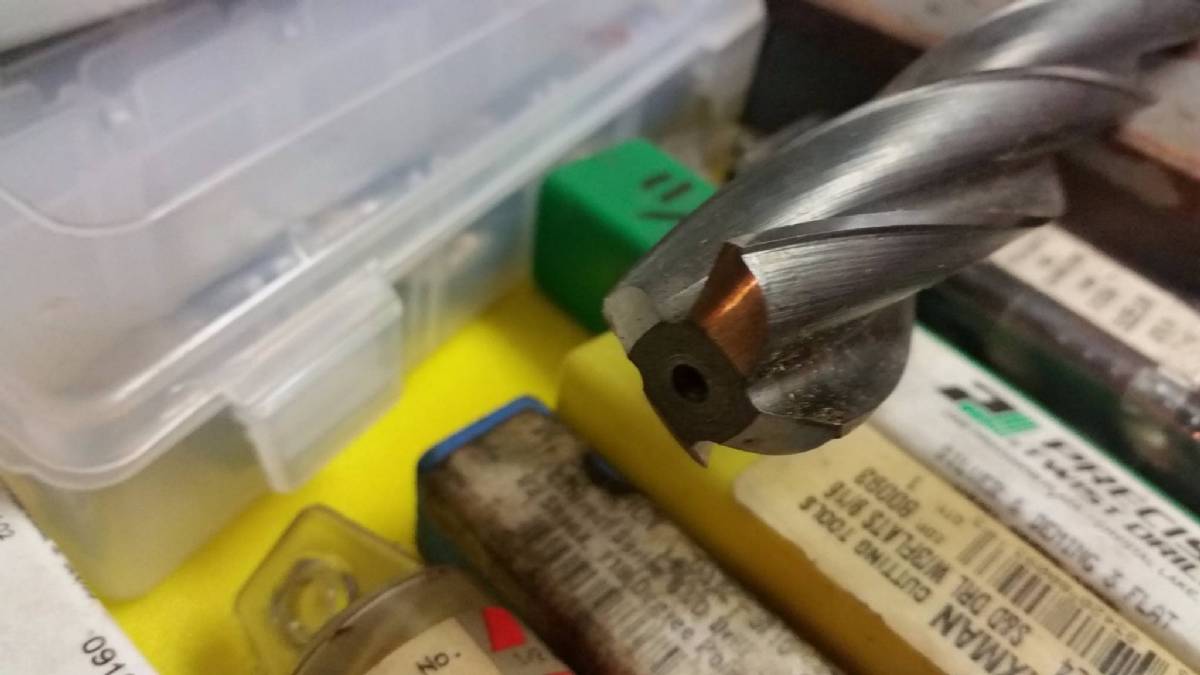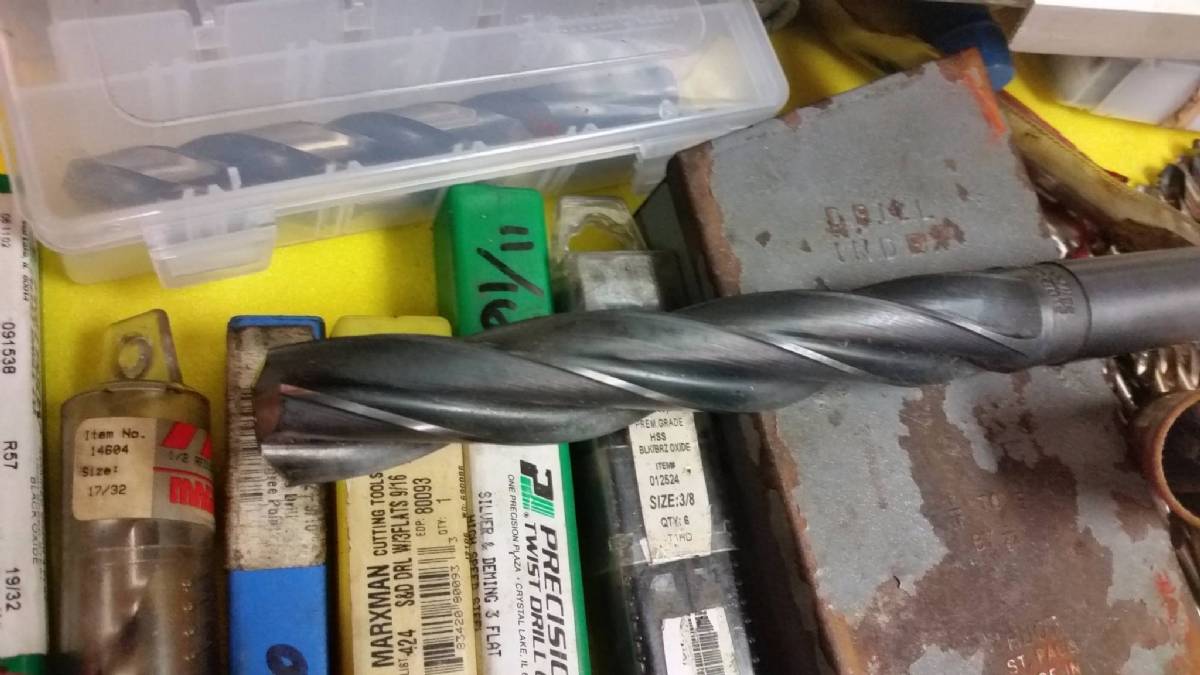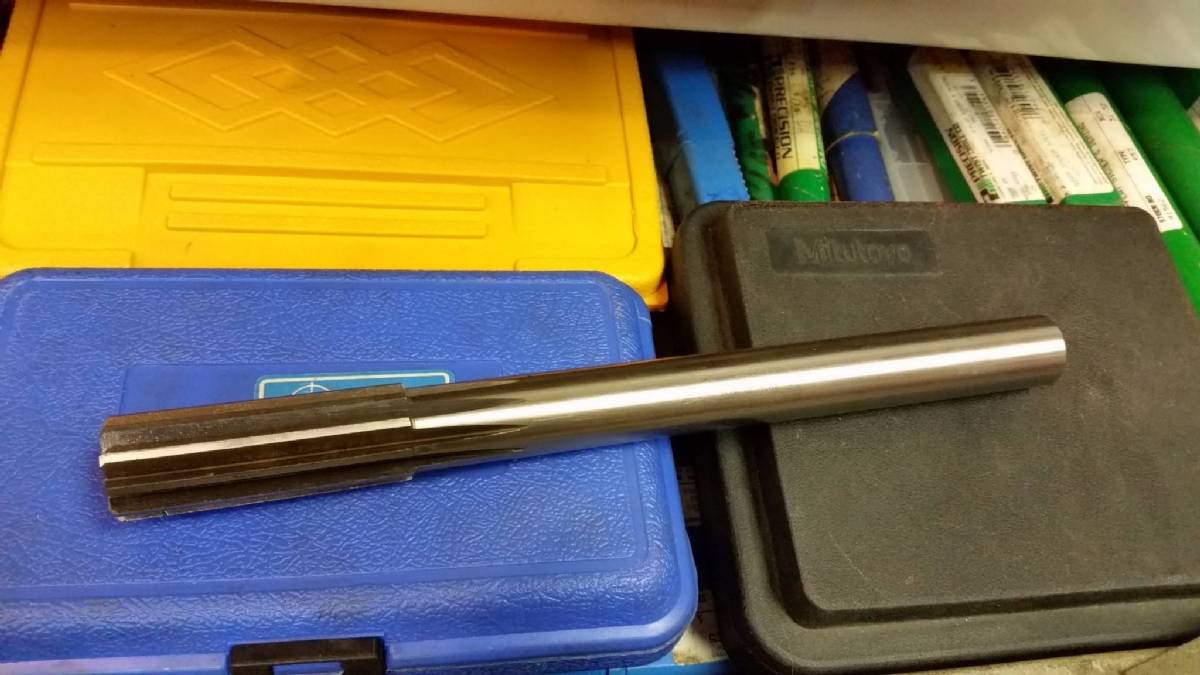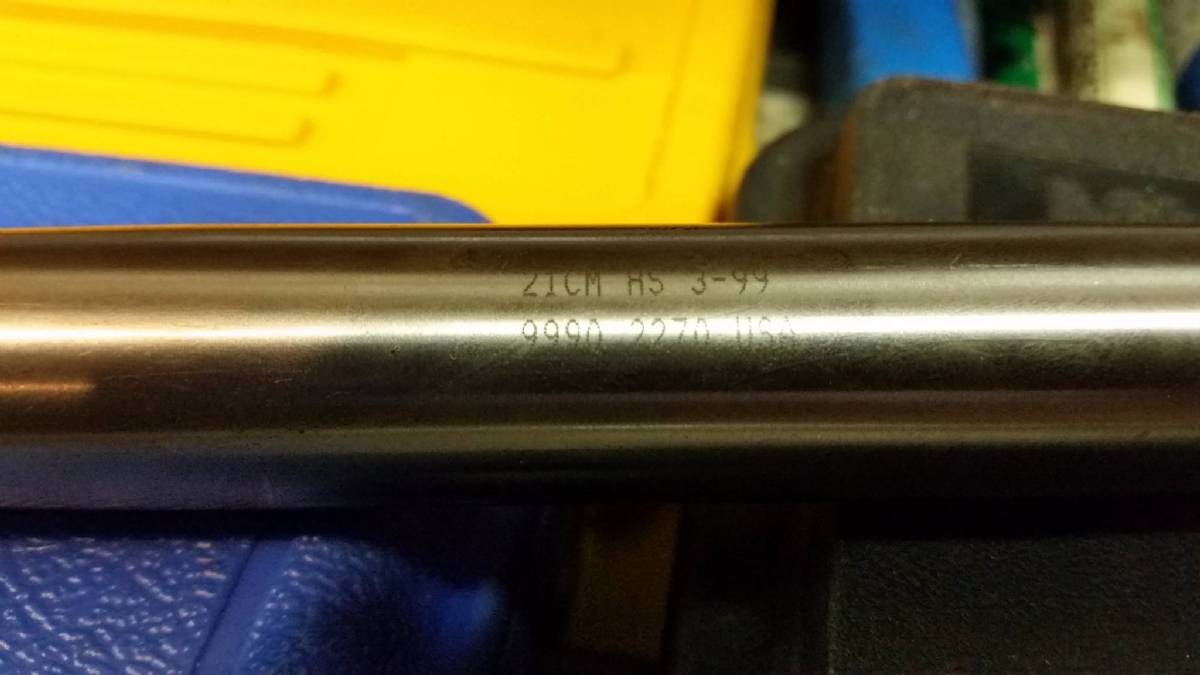How to install the app on iOS
Follow along with the video below to see how to install our site as a web app on your home screen.
Note: This feature may not be available in some browsers.
You are using an out of date browser. It may not display this or other websites correctly.
You should upgrade or use an alternative browser.
You should upgrade or use an alternative browser.
What size drill for 1" reamer?
- Thread starter Jason280
- Start date
- Replies 34
- Views 7,418
CarbideBob
Diamond
- Joined
- Jan 14, 2007
- Location
- Flushing/Flint, Michigan
31/32.
A 63/64 may leave marks that you will not remove due to weld on lips forming and breaking. Drills leave shitty walls.
If you can make that 63/64 drill true and clean less power needed but a reamer at this size can handle a lot of stock.
Either can be made to work but I'd go smaller first as it is not so sensitive to how good your drilled walls and breakout look.
Heck, go crazy and done right with a good tool you can drill it to size, not ream it and hold .0005 or better.
Bob
A 63/64 may leave marks that you will not remove due to weld on lips forming and breaking. Drills leave shitty walls.
If you can make that 63/64 drill true and clean less power needed but a reamer at this size can handle a lot of stock.
Either can be made to work but I'd go smaller first as it is not so sensitive to how good your drilled walls and breakout look.
Heck, go crazy and done right with a good tool you can drill it to size, not ream it and hold .0005 or better.
Bob
Thanks for the suggestions.
Here's my next question, how many "steps" are recommended to get to 31/32? At least, how many pilot holes should be drilled before the final bore of 31/32" The material is mild steel, so nothing exotic or difficult to work with....using a South Bend 16" lathe.
Here's my next question, how many "steps" are recommended to get to 31/32? At least, how many pilot holes should be drilled before the final bore of 31/32" The material is mild steel, so nothing exotic or difficult to work with....using a South Bend 16" lathe.
johansen
Stainless
- Joined
- Aug 16, 2014
- Location
- silverdale wa
Thanks for the suggestions.
Here's my next question, how many "steps" are recommended to get to 31/32? At least, how many pilot holes should be drilled before the final bore of 31/32" The material is mild steel, so nothing exotic or difficult to work with....using a South Bend 16" lathe.
Some of my grandfather's morse taper drill bits work fine in mild steel without a pilot hole, but i've touched them up by hand for center cutting.
I would be concerned about the tail stock being aligned and at the right height to avoid the drill wandering off center. but, i'm using a worn out southbend 9 and the tailstock isn't the stiffest, given the quill is worn out and the whole thing needs to be line bored and a new quill made.
Thanks for the suggestions.
Here's my next question, how many "steps" are recommended to get to 31/32? At least, how many pilot holes should be drilled before the final bore of 31/32" The material is mild steel, so nothing exotic or difficult to work with....using a South Bend 16" lathe.
In the modern world, one shot. On a SB, maybe 1/4” pilot for the drill web and then fire it through. If you’re worried about reamer stock allowance, drill it your next size undersized from 31/32, drill it 31/32 then ream it.
I have learnt to first drill, then bore up, then ream. Bore-up tool has three flutes, it still flexes to some extent in coil form.
If drill makes bad walls, an intermediate turning operation can straighten the bore. It all depends on how good in how much time for how much money.
If drill makes bad walls, an intermediate turning operation can straighten the bore. It all depends on how good in how much time for how much money.
Not familiar with a "bore up tool", may have to look that one up.
I need to check, but now that I think of it I'm pretty sure I have a 1" annular cutter. Only problem with it, I have no way to chuck it up in the tail post, and depth of cut isn't enough to clear the full 3". I could always flip the piece over and cut from both sides, but once again, I have no way to use it in the lathe.
The piece isn't overly critical, but I need the bore to be as close to 0.995-1.000 as possible.
I need to check, but now that I think of it I'm pretty sure I have a 1" annular cutter. Only problem with it, I have no way to chuck it up in the tail post, and depth of cut isn't enough to clear the full 3". I could always flip the piece over and cut from both sides, but once again, I have no way to use it in the lathe.
The piece isn't overly critical, but I need the bore to be as close to 0.995-1.000 as possible.
As mentioned earlier, check to see what size you're drilling before you ream, a drill point hand ground off centre will drill oversize.
It might be worth checking your tailstock height to spindle before you ream. If your tailstock is way worn and .030" low it might a ream bellmouthed hole. Acid test is to ream and see what you get.
If your machine cuts straight could always just bore it to size. Most likely get a nicer finish with a decent tool than you would reaming.
Cheers
D
It might be worth checking your tailstock height to spindle before you ream. If your tailstock is way worn and .030" low it might a ream bellmouthed hole. Acid test is to ream and see what you get.
If your machine cuts straight could always just bore it to size. Most likely get a nicer finish with a decent tool than you would reaming.
Cheers
D
EPAIII
Diamond
- Joined
- Nov 23, 2003
- Location
- Beaumont, TX, USA
Jason, A long time ago I "stepped" up to a large hole size, by 1/8" increments. It was a long process and the drills had to be fed gently to prevent grabbing. No, it was not copper or brass: it was steel. That was the first and LAST time that I tried anything like that.
For best hole location and size I do it this way:
1. Short spotting drill (or center drill). It should be about the size of the next, pilot drill. Carbide is best as it will flex the least and hold the location best. It should only penetrate enough to make a conic shaped dimple: no sharp edge on it. Everything that follows should follow this starter dimple.
2. A pilot drill that is about the size of the web of the final drill.
3. The final drill.
4. Reamer.
That's four steps and it is plenty enough to insure the accuracy of both location and size.
For best hole location and size I do it this way:
1. Short spotting drill (or center drill). It should be about the size of the next, pilot drill. Carbide is best as it will flex the least and hold the location best. It should only penetrate enough to make a conic shaped dimple: no sharp edge on it. Everything that follows should follow this starter dimple.
2. A pilot drill that is about the size of the web of the final drill.
3. The final drill.
4. Reamer.
That's four steps and it is plenty enough to insure the accuracy of both location and size.
Thanks for the suggestions.
Here's my next question, how many "steps" are recommended to get to 31/32? At least, how many pilot holes should be drilled before the final bore of 31/32" The material is mild steel, so nothing exotic or difficult to work with....using a South Bend 16" lathe.
Finegrain
Diamond
- Joined
- Sep 6, 2007
- Location
- Seattle, Washington
When did boring bars go out of favor? Seems like the right tool for this job. Always concentric and on-axis, size is adjustable for fit.
Regards.
Mike
Regards.
Mike
EPAIII
Diamond
- Joined
- Nov 23, 2003
- Location
- Beaumont, TX, USA
The steps that I posted above should work with even this bit. As I said the pilot drill should be the size of the web on it. I would leave as much meat as possible for this, final drill to take off. Just ignore the work "about" in my second step. It needs to be the full size of that flat tip on this drill or just a bit larger.
EPAIII
Diamond
- Joined
- Nov 23, 2003
- Location
- Beaumont, TX, USA
Small holes are easier to ream. For large holes the cost of a reamer gets a lot higher and the boring bar becomes more attractive. Reamers are faster than using a boring bar and that can be an important factor in a commercial operation.
In short, like many things in life, it is a balancing act. In any given shop and job, there is a point that divides the two but it is not a real sharp line. For the most part, I drill and ream up to about 3/4" or 1" diameter and then look to boring bars. But, your dividing line may be different.
If you ever use a boring bar for a 1/8" or smaller hole, please be sure to post the details and some photos. Heck, even a 1/4" hole finished with a boring bar would be interesting.
In short, like many things in life, it is a balancing act. In any given shop and job, there is a point that divides the two but it is not a real sharp line. For the most part, I drill and ream up to about 3/4" or 1" diameter and then look to boring bars. But, your dividing line may be different.
If you ever use a boring bar for a 1/8" or smaller hole, please be sure to post the details and some photos. Heck, even a 1/4" hole finished with a boring bar would be interesting.
When did boring bars go out of favor? Seems like the right tool for this job. Always concentric and on-axis, size is adjustable for fit.
Regards.
Mike
macchi7
Aluminum
- Joined
- Dec 18, 2013
- Location
- Spennymoor, England
Drill to 7/8". Bore to 31/32" then ream to 1".
Boring makes the drilled hole straight which the reamer will then follow. Or just bore to size seeing as you have a 5 thou tolerance
Boring makes the drilled hole straight which the reamer will then follow. Or just bore to size seeing as you have a 5 thou tolerance
I appreciate all the advice and suggestions!
I was able to get the collar bored/reamed, but it was not without its difficulties. Of course, the issues weren't with any of the tooling, but with the lathe itself. Primarily, the morse taper adapters were spinning in the tailstock. The Jacobs chuck that came with the lathe is 3/4" capacity, but with a MT2 taper...which in turn is sleeved into an adapter to work in the South Bend MT3 tapered quill. At first, the chuck was spinning in the adapter, but I was able to remedy that problem. However, once that was fixed, it begin spinning in the SB quill. The chuck and the adapter looked fine, the big problem (at least best I can tell) is the bore of the quill feels scored/scratched.
Any suggestions on fixing the quill issues? Would I be better off replacing the entire quill itself, or picking up an MT3 reamer set and trying to clean it up?
I was able to get the collar bored/reamed, but it was not without its difficulties. Of course, the issues weren't with any of the tooling, but with the lathe itself. Primarily, the morse taper adapters were spinning in the tailstock. The Jacobs chuck that came with the lathe is 3/4" capacity, but with a MT2 taper...which in turn is sleeved into an adapter to work in the South Bend MT3 tapered quill. At first, the chuck was spinning in the adapter, but I was able to remedy that problem. However, once that was fixed, it begin spinning in the SB quill. The chuck and the adapter looked fine, the big problem (at least best I can tell) is the bore of the quill feels scored/scratched.
Any suggestions on fixing the quill issues? Would I be better off replacing the entire quill itself, or picking up an MT3 reamer set and trying to clean it up?
I appreciate all the advice and suggestions!
I was able to get the collar bored/reamed, but it was not without its difficulties. Of course, the issues weren't with any of the tooling, but with the lathe itself. Primarily, the morse taper adapters were spinning in the tailstock. The Jacobs chuck that came with the lathe is 3/4" capacity, but with a MT2 taper...which in turn is sleeved into an adapter to work in the South Bend MT3 tapered quill. At first, the chuck was spinning in the adapter, but I was able to remedy that problem. However, once that was fixed, it begin spinning in the SB quill. The chuck and the adapter looked fine, the big problem (at least best I can tell) is the bore of the quill feels scored/scratched.
Any suggestions on fixing the quill issues? Would I be better off replacing the entire quill itself, or picking up an MT3 reamer set and trying to clean it up?
They should all drive off the tang on the chuck shank/adaptor, got any pics?
If the tailstock quill is soft enough to file you can ream it, just enough to take out high spots, if its to hard you can lap it. Im more interested why the adaptor span, sounds like theres nothing in the TS quill to lock it. Pics of the quill would help.
Similar threads
- Replies
- 3
- Views
- 410


